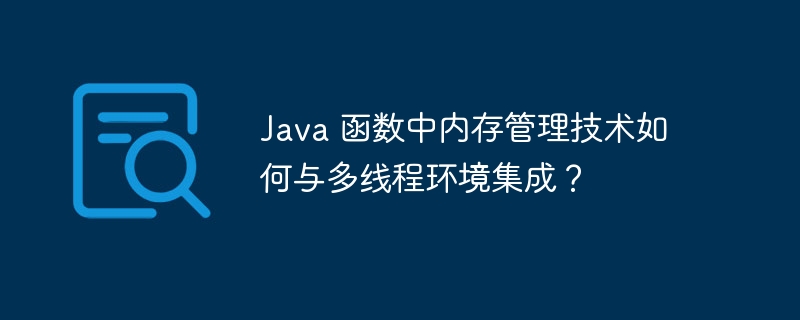Home >Java >javaTutorial >How do memory management techniques in Java functions integrate with multi-threaded environments?
How do memory management techniques in Java functions integrate with multi-threaded environments?
- WBOYWBOYWBOYWBOYWBOYWBOYWBOYWBOYWBOYWBOYWBOYWBOYWBOriginal
- 2024-04-30 15:45:02663browse
The memory management technology in Java is seamlessly integrated into the multi-threaded environment to ensure data integrity: Garbage Collection (GC) automatically recycles objects to prevent memory leaks; the reference queue is used to notify the GC of objects that are no longer used; concurrent marking Scan (CMS) reduces GC pause time; incremental mark clearing (G1) executes the GC process concurrently, providing lower pause time.

#How do memory management techniques in Java functions integrate with multi-threaded environments?
In a multi-threaded environment, memory management becomes crucial as it ensures safe and efficient memory access between threads. Java provides a range of memory management techniques that integrate seamlessly with multi-threaded environments to ensure data integrity and application performance.
Garbage Collection (GC)
GC is a basic memory management technology in Java. It automatically recycles objects that are no longer used, frees memory and prevents memory leaks. Since GC is automatic, programmers do not have to manually manage memory.
In a multi-threaded environment, GC must consider the situation of multiple threads accessing memory concurrently. To ensure thread safety, GC pauses all threads while executing. However, this may result in longer application response times.
Reference Queue
The reference queue is a special queue used to notify the GC when an object is no longer referenced by any thread. This is more efficient than the GC periodically scanning all objects to check if they are still in use. In a multi-threaded environment, reference queues help the GC identify objects that are no longer used and reclaim them in a timely manner.
Concurrent Mark Scan (CMS)
CMS is a variant of GC designed for multi-threaded environments. It executes the mark phase and scan phase in parallel, thereby reducing GC pause times. CMS is suitable for larger heaps because it has lower overhead, but it may result in longer garbage collection delays.
Incremental Mark Sweep (G1)
G1 is another modern variant of GC that uses a generational algorithm to divide the heap into different regions. G1 performs mark and sweep processes in parallel, minimizing GC pause times. It also allows applications to define periods of time during which the GC is delayed, thereby improving performance.
Practical Case
Suppose we have a multi-threaded application that shares a counter and need to ensure that the counter is synchronized among all threads. We can use the synchronized keyword in the shared counter class to ensure atomicity of access, as shown below:
public class SharedCounter {
private int count;
public synchronized void increment() {
count++;
}
public synchronized int getCount() {
return count;
}
}By using the synchronized keyword, we ensure that every Only one thread at a time can access the counter, preventing race conditions and data inconsistencies. This can be used in conjunction with the GC techniques mentioned above to ensure efficient memory management and avoid any memory leaks or other concurrency issues.
The above is the detailed content of How do memory management techniques in Java functions integrate with multi-threaded environments?. For more information, please follow other related articles on the PHP Chinese website!

